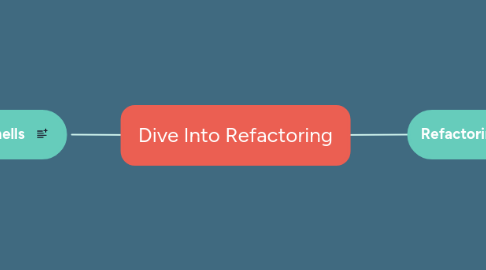
1. Code Smells
1.1. Bloaters
1.1.1. Long Method
1.1.2. Large Class
1.1.3. Primitive Obsession
1.1.4. Long Parameter List
1.1.5. Data Clumps
1.2. Object Oriented Abusers
1.2.1. Switch Statement
1.2.2. Temporary Field
1.2.3. Refused Bequest
1.2.4. Alternative Class with different Interfaces
1.3. Change Preventers
1.3.1. Divergent Change
1.3.2. Shotgun Surgery
1.3.3. Parallel Inheritance Hierarchies
1.4. Dispensables
1.4.1. Comments
1.4.2. Duplicate Code
1.4.3. Lazy Class
1.4.4. Data Class
1.4.5. Dead Code
1.4.6. Speculative Generality
1.5. Couplers
1.5.1. Feature Envy
1.5.2. Inappropriate Intimacy
1.5.3. Message Chains
1.5.4. Middle Man
1.5.5. Incomplete Library Class
2. Refactorings
2.1. Composing Methods
2.1.1. Extract Method
2.1.2. Inline Method
2.1.3. Extract Variable
2.1.4. Inline Temp
2.1.5. Replace Temp with Query
2.1.6. Split Temporary Variable
2.1.7. Remove Assignments to Parameters
2.1.8. Replace Method with Method Object
2.1.9. Substitute Algorithm
2.2. Moving Features between Objects
2.2.1. Move Method
2.2.2. Move Field
2.2.3. Extract Class
2.2.4. Inline Class
2.2.5. Hide Delegate
2.2.6. Remove Middle Man
2.2.7. Introduce Foreign Method
2.2.8. Introduce Local Extension
2.3. Organizing Data
2.3.1. Self Encapsulate Field
2.3.2. Replace Data Value with Object
2.3.3. Change Value to Reference
2.3.4. Change Reference to Value
2.3.5. Replace Array with Object
2.3.6. Duplicate Observed Data
2.3.7. Change Unidirectional Association to Bidirectional
2.3.8. Change Bidirectional Association to Unidirectional
2.3.9. Replace Magic Number with Symbolic Constant
2.3.10. Encapsulate Field
2.3.11. Encapsulate Collection
2.3.12. Replace Type Code with Class
2.3.13. Replace Type Code with Subclasses
2.3.14. Replace Type Code with State/Strategy
2.3.15. Replace Subclass with Fields
2.4. Simplifying Conditional Expressions
2.4.1. Decompose Conditional
2.4.2. Consolidate Conditional Expression
2.4.3. Consolidate Duplicate Conditional Fragments
2.4.4. Remove Control Flag
2.4.5. Replace Nested Conditional with Guard Clauses
2.4.6. Replace Conditional with Polymorphism
2.4.7. Introduce Assertion
2.4.8. Introduce Null Object
2.5. Simplifying Method Calls
2.5.1. Rename Method
2.5.2. Add Parameter
2.5.3. Remove Parameter
2.5.4. Separate Query from Modifier
2.5.5. Parameterize Method
2.5.6. Replace Parameter with Explicit Methods
2.5.7. Preserve Whole Object
2.5.8. Replace Parameter with Method Call
2.5.9. Introduce Parameter Object
2.5.10. Remove Setting Method
2.5.11. Hide Method
2.5.12. Replace Constructor with Factory Method
2.5.13. Replace Error Code with Exception
2.5.14. Replace Exception with Test
2.6. Dealing with Generalisation
2.6.1. Pull Up Field
2.6.2. Pull Up Method
2.6.3. Pull Up Constructor Body
2.6.4. Push Down Field
2.6.5. Push Down Method
2.6.6. Extract Subclass
2.6.7. Extract Superclass
2.6.8. Extract Interface
2.6.9. Collapse Hierarchy
2.6.10. Form Template Method
2.6.11. Replace Inheritance with Delegation
2.6.12. Replace Delegation with Inheritance
